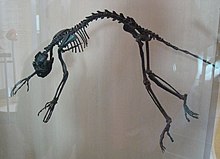This article needs additional citations for verification. (March 2015) |
| Notharctus tenebrosus Temporal range: Eocene
| |
|---|---|

| |
| Notharctus tenebrosus | |
| Scientific classification | |
| Domain: | Eukaryota |
| Kingdom: | Animalia |
| Phylum: | Chordata |
| Class: | Mammalia |
| Order: | Primates |
| Suborder: | Strepsirrhini |
| Family: | †Notharctidae |
| Genus: | †Notharctus |
| Species: | †N. tenebrosus
|
| Binomial name | |
| †Notharctus tenebrosus Leidy, 1870
| |
Notharctus tenebrosus was an early primate from the early Eocene, some 54–38 million years ago. Its fossil was found by Ferdinand V. Hayden in 1870 in southwestern Wyoming. When first found, Notharctus tenebrosus was thought to be a small pachyderm due to the concentration of pachyderm fossils in the area. However, after Walter W. Granger's discovery of a nearly complete skeleton, also in Wyoming, it was firmly established as a primate. Notharctus tenebrosus most resembles modern-day lemurs, although they are not directly related.
Notharctus tenebrosus belonged to an extinct primate group known as Adapiformes and fossils have been found in North America. Adapiform primates were among the first primates to exhibit a set of adaptations for life in the trees, such as grasping hands, binocular vision, and flexible backs. In addition to this, small orbits in the genera indicate that they were diurnal.
"Notharctus" means false bear, while "tenebrosus" means dark or gloomy.